The Checker Maven
A Grand Rapids 4th
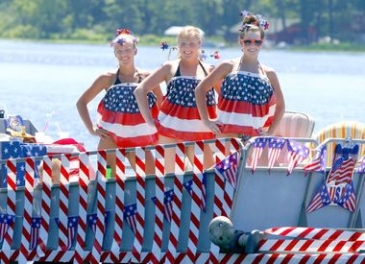
Once again, we take the annual opportunity to remark that as unabashed and unapologetic patriots we greatly enjoy celebrating the 4th of July holiday. For us, that celebration always includes the publication of a fine checker problem by an American composer.
A little while back, we discovered the astonishing work of late 19th century checkerist O. H. Richmond, of Grand Rapids, Michigan (an all-American town if there ever was one, as the photo above illustrates). Today we're pleased to present another of Mr. Richmond's fine problems with the hope that you will enjoy it as much as we did.
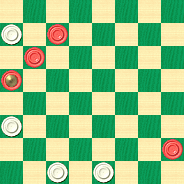
WHITE
White to Play and Win
W:W5,21,30,31:B6,9,K13,28.
Join us in including checkers in your 4th of July festivities. Solve the problem, and then click on Read More to see the solution.![]()
An Evening's Study

Study is usually a good thing; it's often an important part of the road to success in many an endeavor, checkers not the least among them. Sometimes, though, it gets a little overwhelming, and we sympathize with the poor student shown above, who seems to have gone into something like "study meltdown."
As today's entry in our Checker School series, we present a problem that the great checker writer Ben Boland called An Evening's Study. We suspect that there's enough material here for much more than a single evening, and we advise you to avoid the fate of our hapless student. Take your time and enjoy rather than trying to cram it all in at once.
BLACK
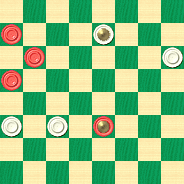
WHITE
White to Play and Win
W:W22,21,12,K7:BK23,13,9,5.
Will you be an "A" student on this one, or will your grade be somewhat lower? It's up to you; put in your study time and then click on Read More to see the solution, sample games, and detailed study notes.![]()
The Jaques Shot
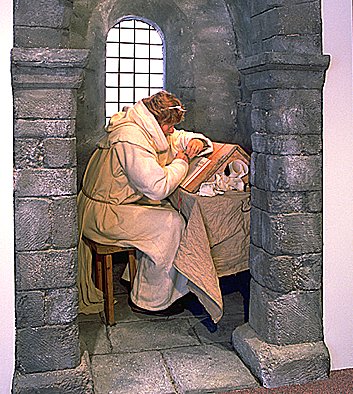
We've all heard the well-known French children's song Frere Jaques, but we'll guess that relatively few of us are familiar with its origins and possible meanings. Frere Jaques is usually translated as "Brother John," but "brother" can refer to a monk as well as a sibling. In fact, there's some evidence that Frere Jaques is related to Girolamo Frescobaldi's Fra Jacopino, lending credence to the "monk" theory.
We don't think Fra Jacopino, or Frere Jaques for that matter, were checker players, though perhaps they knew of an older version of the game. In any case, the subject of today's column, a different Jaques, was certainly a checkerist. Willie Ryan, in his seminal work Tricks Traps & Shots of the Checkerboard, gives us the scoop.
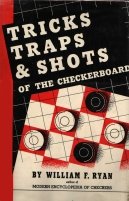
"One of the prettiest of all strokes is the much heralded Jacques Shot. E. Jacques, of Canada, used it for the first time in defeating a player by the name of Campbell, first name unknown. Invariably, writers have used the order of moves played in the Campbell-Jacques game to illustrate the stroke, but as explained in my note B, this invalidates the scientific value of the coup. It is neither practical nor advisable to make a losing move to bait a trap. Any experienced player knows better than to take such a risk. In my treatment of the Jacques stroke, the correct order of moves is given so that white can play for the shot without making a losing move at any point.
| 9-13 | 11-16 | 13-17 |
| 24-19 | 25-21 | 31-26---3 |
| 11-16 | 6-9 | 9-13---4 |
| 22-18 | 23-18 | 25-22 |
| 8-11 | 16-23 | 12-16 |
| 28-24 | 26-19 | 15-10 |
| 16-20 | 4-8---A | 2-7---C. |
| 18-14 | 29-25 | Now see the |
| 10-17 | 7-11---B | diagram. |
| 21-14 | 19-15 |
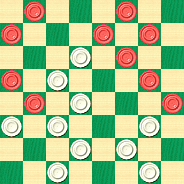
WHITE
White to Play and Win
W:W32,30,27,26,24,22,21,18,14,10:B20,17,16,13,11,8,7,5,3,1.
A---The following is much stronger---1, and almost makes the run-up on the Jacques Shot untenable: 13-17, 18-15* (the only move to draw), 9-18, 21-14, 18-22, 30-25*, 7-10, 14-7*, 2-18, 27-23*, 18-27 (20-27, 23-14, 22-26, 32-23, 26-30, 25-21, 1-6, 23-18, a draw), 25-18, 5-9, 32-23, 20-27, 31-24, 9-13, 19-15, 13-17, 18-14, 17-22, 14-10, 22-26, 23-19, 4-8, 24-20*, 26-31, 20-16, 31-27, 29-25*, 27-24 (27-23, 25-22*, 23-27, 10-6*, a draw), 16-11, 24-20, 11-4, 20-16, 4-8, 16-23, 15-11, 12-16, 8-12, etc.; a draw. Wm. F. Ryan.
B---If 8-11 is played here, then white's only move to draw is 25-22*---2. In the historical Campbell-Jacques game, 13-17 was played; white (Jacques) replied with 31-26, which loses for black by: 8-11, 32-28 (25-22, 11-15, black wins), 17-22, 26-17, 11-15, 19-10, 9-13, 25-22, 5-9, 14-5, 7-32, 24-19, 32-27, etc. F. F. Smith, Birmingham, England. However, if after 13-17 at B, white replies with: 18-15, 9-18, 21-14, a draw by black will be difficult. Hence, to reach the Jacques Shot scientifically without either side making a losing move, 7-11 must be played before 13-17, as the latter move virtually loses at this point.
C---The losing move, and it forms the great Jacques Stroke. Although this classical 12-piece clearance has been essayed and acclaimed by 1001 writers on the game, not one has ever attempted to show black's losing move, nor has any authority ever published the play leading up to the shot in the proper scientific sequence. This is not unlike a musician with rheumatic fingers trying to do justice to a fine rhapsody on a rusty instrument that is out of tune. My examination of the situation shows that instead of 2-7 at C, black can effect the following beautiful draw, two pieces short: 16-19*!, 24-15, 2-7*, 27-24, 20-27, 32-23, 5-9, 14-5, 7-14, 18-9, 11-27, 21-14, 3-7*!, 26-23, 27-31, 23-19, 13-17*!, 22-13, 8-11, 30-25, 31-27, 25-21, 27-23, 21-17, 23-16, 9-6, 1-10, 5-1, 16-12, 13-9, 10-15, 1-6, 11-16. Wm. F. Ryan. This draw is almost as good as the shot!"
1---The computer doesn't see any real difference between the two moves---Ed.
2---The computer gives 32-28 to draw and sees 25-22 as a possible White loss---Ed.
3---A probable loss for White; 30-26 was required here. We're a little surprised Willie missed this---Ed.
4---But Black gives away all the advantage. 11-16 likely would have won---Ed.
You don't need to be a monk, speak French or Italian, or be familiar with musical history to solve the problem diagrammed above. You do need to be a pretty good checker player, though. When you've found la solution (or should that be la soluzione?) click your mouse on Read More to check your work.![]()
Marvin Opens the Season
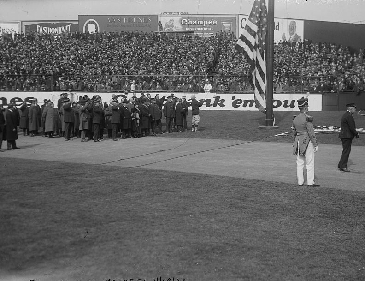
It was the opening day of the summer season. Marvin J. Mavin, captain of the National Checker League's Detroit Doublejumpers, had lead his team to a second-place finish in the winter season, and was hoping to go all the way this time. The opener was taking place on the road, with the Doublejumpers facing the Pittsburgh Paisleys in the first game of a four-game series.

Marvin J. Mavin
Marvin learned a hard lesson during his exile to the minor leagues (see previous Checker Maven column), and had laid off the beer during the playing season. Unfortunately, his girlfriend Priscilla had been away on business in Turkmenistan during the inter-season break, and absent her watchful eye Marvin had backslid--- more than a little.
In short, Marvin wasn't quite in the best condition for today's match. And he had to face the Paisleys' top player, Karl "the Mauler" Mortenson. The two sat facing each other over the board in the center of the huge stadium, which was packed with fervent checker fans eager for the start of the new season. The National Anthem was played and the players took their seats. Marvin and Karl shook hands. Karl gave Marvin his signature "Pittsburgh Can Crusher" handshake, and it was all Marvin could do not to howl with pain. "Hey, man, that's the hand I move the pieces with," he said, "lay off a little." But Karl just grinned and said something about sissies and wusses.
But then, accompanied by a great cheer from the crowd, the match began.

Karl "the Mauler" Mortenson
Black: Karl Mortenson
White: Marvin J. Mavin
| 1. | 9-14 | 22-18 |
| 2. | 5-9 | 24-19 |
| 3. | 11-15 | 18x11 |
| 4. | 8x24 | 28x19 |
| 5. | 4-8 | 25-22 |
| 6. | 8-11 | 22-18 |
| 7. | 11-16 | 29-25 |
| 8. | 7-11 | 25-22 |
| 9. | 10-15 | 19x10 |
| 10. | 6x15 | 27-24 |
| 11. | 16-20 | 23-19 |
| 12. | 20x27 |
"Big bad dude doesn't know book play," Marvin muttered. Indeed, while the text move is fine, 14-23 is usual. "Yeah, well I know a few new tricks, wussie," Karl growled back.
| 12. | ... | 19x10 |
| 13. | 14x23 | 26x19 |
| 14. | 9-13 | 31x24 |
| 15. | 2-7 | 30-26 |
| 16. | 7x14 | 26-23 |
| 17. | 3-7 | 24-20 |
| 18. | 7-10 | 32-28 |
Marvin was sweating, and his head was pounding; he was regretting the excesses of the past week. If he lost today, Priscilla would instantly realize that he had gone off the wagon, and when she returned home she would show him no mercy.
| 19. | 1-5 | 22-18 |
| 20. | 5-9 | 28-24 |
| 21. | 13-17 |
"Take that, you wimp," Karl said. "You're dead meat, little boy."
Marvin knew he was in tough straits. Every move on the board seemed to lose two men. He had to pull out a draw, not only to save the game, but to save his hide. Karl thought he was some kind of tough guy, but Marvin knew that you haven't seen tough until you've been on the wrong side of Priscilla.
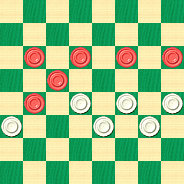
WHITE
White to Play and Draw
W:W24,23,21,20,19,18:B17,14,12,11,10,9.
Can you find the draw here, or would you too face the equivalent of Priscilla's wrath? All we can say is that we think it might be best to solve the problem! Find the draw and then click on Read More to see the solution and the rest of our story.![]()
2nd Edition of "How to Win at Checkers"

A revised and corrected 2nd edition of Fred Reinfeld's How to Win at Checkers is now available here or from the link on the right side of the page. The revised edition fixes a quirk in the rendering of the board diagrams and includes detailed errata graciously provided by Mr. George Hay. We hope you both enjoy and benefit from Mr. Reinfeld's classic work.
A Grand Rapids Speedster
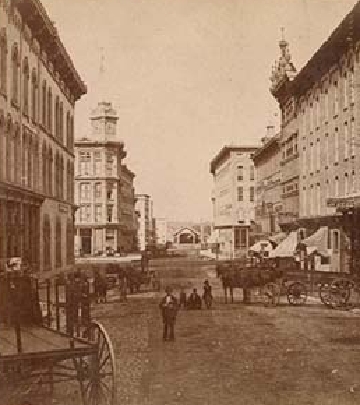
Today's problem has quite a history. It's credited to an American, a Mr. O. H. Richmond of Grand Rapids, Michigan, but it was actually published in Glasgow, Scotland, some time in the 1880s. Grand Rapids in the 1880s was a town of less than 60,000, mostly known for its production of fine furniture. In the world of checkers as well, it apparently had international reach.
And now, something like 125 years later, we too can enjoy this excellent problem. We're presenting it as a speed problem (what else would we do with a problem from Grand "Rapids"), but we must say that it pushes the limit for speed solving. For this reason, we'll allow 30 seconds for the solution. Our guess is that you'll either see it right away, or you won't. We rate the problem as medium to hard in difficulty; medium if you take your time, and hard if you try to stay within the 30 second time limit.
When you're ready, click on the link below to show the problem and start the clock. When you're finished, come back and click on Read More to see the startling solution.
June Speed Problem (medium to hard, 30 seconds)
![]()
